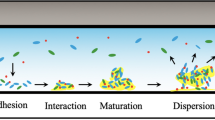Abstract
The magnetococcus, a magnetotactic bacterium, has been grown in a complex simulated natural environment. Sufficiently pure samples of cells were obtained magnetically making axenic cultures unnecessary for many purposes. The magnetococcus is a Gram-negative coccus, 1.6 μm in diameter and readily distinguished by highly refractile inclusions and its magnetotactic behavior. This organism is actively motile by means of two bundles of flagella. Electron dense ferromagnetic inclusions were localized between the flagellar bundles. Collections of magnetococci were morphologically homogeneous and negligibly contaminated by extraneous bacteria. DNA extracted from pooled collections of cells was homogeneous by analytical CsCl centrifugation. The guanine-cytosine content was 61.7%. Total iron by percent cellular dry weight was 3.8%. Comparisons with a previously described magnetotactic marine coccus were made.
Similar content being viewed by others
Abbreviations
- Tris:
-
Tris (hydroxymethyl) aminomethane buffer
- EDTA:
-
Dipotassium ethylenediamine tetraacetic acid
- GC:
-
Guanosine cytosine
References
Adler, J.: Chemotaxis in bacteria. Science153, 708–716 (1966)
Anonymous: Microbial magnets. Sci. Am.238, 73–74 (1978)
Berg, H. C., Brown, D. A.: Chemotaxis inEscherichia coli analyzed by three-dimensional tracking. Antibiot. Chemother. (Basel)19, 55–78 (1974)
Blakemore, R.: Magnetotactic bacteria. Science190, 377–379 (1975)
Brown, F. A., Jr., Bennet, M. F., Webb, H. M.: A magnetic compass response of an organism. Biol. Bull.119, 65–74 (1960)
Doetsch, R. N., Schneider, W. R.: Velocity measurements of motile bacteria by use of a videotape recording technique. Appl. Microbiol.27, 283–284 (1974)
Freke, A. M., Tate, D.: The formation of magnetic iron sulphide by bacterial reduction of iron solutions. J. Biochem. Microbiol. Tech. Eng.3, 29–39 (1961)
Gibbs, C. R.: Characterization and application of ferrozine iron reagent as a ferrous iron indicator. Anal. Chem.48, 1197–1201 (1976)
Izak, G.: Proposed recommendation for measurement of serum iron in human blood. J. Clin. Path.24, 334–335 (1971)
Jones, H. E., Trudinger, P. A., Chambers, L. A., Pyliotis, N. A.: Metal accumulation by bacteria with particular reference to dissimilatory sulphate-reducing bactera. Z. Allg. Mikrobiol.16, 425–435 (1976)
Larkin, T. S., Keeton, W. T.: Bar magnets mask the effect of normal magnetic disturbances on pigeon orientation. J. Comp. Physiol.110, 227–231 (1976)
Lees, H., Kwok, S. C., Suzuki, I.: The thermodynamics of iron oxidation by ferrobacilli. Can. J. Microbiol.15, 43–46 (1969)
Mallette, M. F.: Evaluation of growth by physical and chemical means. In: Methods in microbiology (J. R. Norris, D. W. Ribbons, ed.), Vol. 1, pp. 532–556. London: Academic Press 1969
Murray, R. G. E., Birch-Anderson, A.: Specialized structure in the region of the flagella tuft inSpirillum serpens. Can. J. Microbiol.9, 393–401 (1963)
Neilands, J. B.: Iron and its role in microbial physiology. In: Microbial iron metabolism: A comprehensive treatise (J. B. Neilands, ed.), pp. 3–34. New York: Academic Press 1974
Palmer, J. D.: Organismic spatial orientation in very weak magnetic fields. Nature198, 1061–1062 (1963)
Presman, A. S.: Electomagnetic fields and life. New York: Plenum Press 1970
Strength, N. J., Isani, B., Linn, D. M., Williams, F. D., Vandermolen, G. E., Laughon, B. E., Krieg, N. R.: Isolation and characterization ofAquaspirillum fasciculus sp. nov. a rod-shaped, nitrogen-fixing bacterium having unusual flagella. Int. J. Syst. Bacteriol.26, 253–268 (1976)
Stumm, W., Morgan, J. J.: Case studies: Phosphorous, iron and manganese. In: Aquatic chemistry (W. Stumm, J. J. Morgan, eds.), pp. 514–563, New York: Wiley 1970
Taylor, B. L., Koshland, D. E., Jr.: Reversal of flagellar rotation in monotrichous and peritrichous bacteria: Generation of changes in direction. J. Bacteriol.119, 640–642 (1974)
Author information
Authors and Affiliations
Rights and permissions
About this article
Cite this article
Moench, T.T., Konetzka, W.A. A novel method for the isolation and study of a magnetotactic bacterium. Arch. Microbiol. 119, 203–212 (1978). https://doi.org/10.1007/BF00964274
Received:
Issue Date:
DOI: https://doi.org/10.1007/BF00964274




